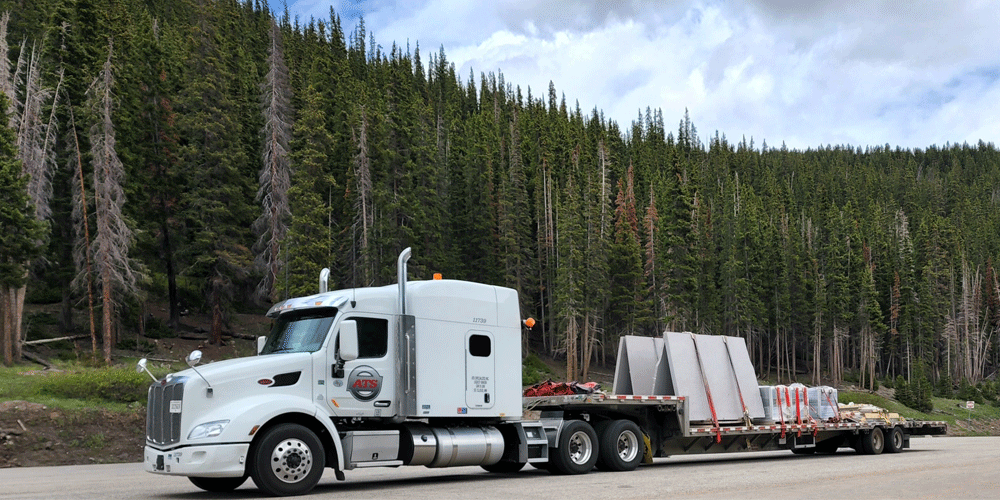
As a truck driver, you’ve probably hauled a lot of different types of loads (maybe on a lot of different types of flatbed trailers) in your career. Flatbed trailer weight placement will change from load to load and there’s no exact science. Still, it can be helpful to know a few best practice tips for trailer weight placement — especially as a flatbed driver.
Sometimes you might not know exactly how you should be loaded and the customer might not always load you the right way. While the customers are usually good at loading you properly, it’s ultimately your responsibility to make sure the weight on your trailer is properly distributed.
Part of my job at Anderson Trucking Service (ATS) is to help our drivers feel confident about securing their loads. I want to do the same thing for you.
There are many variables to think about when you’re placing your loads and securing them. In this article, I’ll help you understand some best practices that you can apply to every load — no matter how big or small.
Why is Weight Distribution Important?
Let’s start with the basics. Why does it matter where you place your cargo on your trailer?
It’s simple: Improperly loading cargo can lead to issues with being overweight. You can either be overweight on your axle groups or your entire vehicle can exceed gross vehicle weight requirements.
If you’re overweight and you’re caught at a weigh station, you can receive weight-related violations which can be costly and lead to other significant consequences. In certain states, you may even be sent to jail. Some states take overweight violations very seriously.
Not only can a violation cost you thousands of dollars, but you may also have to shut down your operation until you can legalize your load. That can look different depending on how heavy you are. Either you’ll need to change the vehicle by adjusting the axles or you’ll need to redistribute the weight by moving the freight around. If the situation can’t be corrected by adjusting the vehicle or redistributing the weight because the gross weight is over, you’ll need to remove some weight.
You’ll have to wait for another truck to arrive to take some of your excess weight. It’ll be extremely expensive and time-consuming to get another truck to your location to pick up the excess weight. In the meantime, you’ll be sitting there not making money. You’ll also have to pay someone — like a tow company — to help you move that freight from one trailer to the next.
Depending on what type of driver you are (company driver versus owner-operator under your own authority) you may or may not have to cover the cost of this expense.
The maximum legal weight for a commercial motor vehicle is 80,000 pounds. Typically in most states, drivers can load 12,000 pounds on the steer tires, 34,000 pounds on the drive tires and 34,000 pounds on the trailer if you have a standard tandem trailer.
Anything exceeding that weight will need an overweight permit and may be restricted from driving on certain roads. The excess truck weight can damage roadways and bridges, therefore compromising their structure.
You can only get an overweight permit if it’s a single piece. If it’s more than one piece, it’s considered reducible. That means you can reduce the weight of the load by removing a piece from the load.
For example, van trailers cannot get an overweight permit. Because there are usually pallets of products or goods loaded in the dry van, they can remove pallets to make sure it meets the legal weight requirements. On the other hand, the flatbed side of things is totally different because one single piece of equipment can weigh over legal weight requirements on its own.
Regardless, being overweight is going to lead to some heartburn, whether you’re paying fines, paying for permits or waiting for someone to pick up cargo from you.
5 Tips for Trailer Weight Placement
These general tips will help you properly place your weight so you’re always sitting at the proper weight when you get to scales.
1. Know What your Tractor and Trailer Weigh
Do you know how much your tractor and trailer weigh empty? It’s crucial to know how much your truck and trailer weigh before you get loaded. You need to know what you’re starting with because not every truck and trailer weigh the same.
This is easily the most important part of proper weight distribution but it’s one of the most misunderstood factors. Countless variables factor into your empty weight, from how many axles you have to whether you have a day cab or a sleeper berth truck.
As a flatbed driver, you’ll be loaded down with tarps, straps and chains for securement. The size of your trailer makes a difference too. You might be hauling a 48-foot trailer or a 53-foot trailer. Some trailers are made of steel and some are made of aluminum. The heavier you are to start with, the less freight you can haul.
Before you arrive at a pickup destination, know your empty weight and know how much you can haul before you hit 80,000 pounds. Stick to your guns on this when talking to shippers; you’re the one who knows this information better than anyone else.
2. Know Where Your Center for Weight Distribution Is
If you put your trailer on a teeter-totter, where would it balance perfectly? If you place the center point too far forward or too far back, it won’t balance. On a teeter-totter, it will fall to one side or the other. On your truck and trailer, you’ll be overweight on one side or the other.
You can find the center point for weight distribution by measuring the distance from the kingpin to the center of your suspension and then half the distance to the back of the trailer.

Then, decide if you want to load half of the weight in front of the center point and half of the weight behind it to avoid overloading the truck.
Balancing the weight like this is generally a good idea.
Air-weigh on-board can give you a sense of where the weight is placed on your vehicle. However, not all trucks and trailers are equipped with them.
3. Weigh in After You’re Loaded and Secured
When in doubt, after you're loaded and your load is secure, go to the nearest scale and check your weight. It’s easier to do this than to let a Department of Transportation (DOT) scale be your guide because if you’re overweight on their scale you’ll be in trouble.
There’s really no excuse for being overweight, ever, so most officers won’t give you a break at a weigh station if you’re in violation.
4. Be Mindful of Heavy Loads
If you’re only picking up 20,000 or 30,000 pounds of freight, basically no matter where you put it, you can’t go wrong because, alongside the weight of your truck and trailer, you won’t even be close to that 80,000-pound mark.
It’s when you get into the 40,000 to 50,000-pound loads that you’ll be pushing gross vehicle weight and axle weight maximums. When heavier loads come, placement is more critical.
5. Work with the Customer
While it ultimately falls on you to ensure that your truck is legal for the road, you can work with the customer if you need additional help.
The customer should know their freight well and be able to talk about its weight. They don’t want to place the freight incorrectly either, because if they do, it can cause you to have to come back and they’ll have to work with you again to place it. This ultimately delays the process and their freight will arrive later.
Also, consider that not every customer is used to loading the type of trailer you’re hauling. Some vehicles have intricacies that the driver is aware of but the customer is not. Collaborate with the customer to get the best result.
Establishing a good working relationship will help you get the best results. If there’s an issue, try to work through it calmly. If you feel like you’re not being loaded right, try to negotiate changes with them.
If you have concerns and don’t feel like the customer is working with you, call your dispatcher. They should be able to help you to determine the best solution. They can also get customer service involved to speak with the customer.

